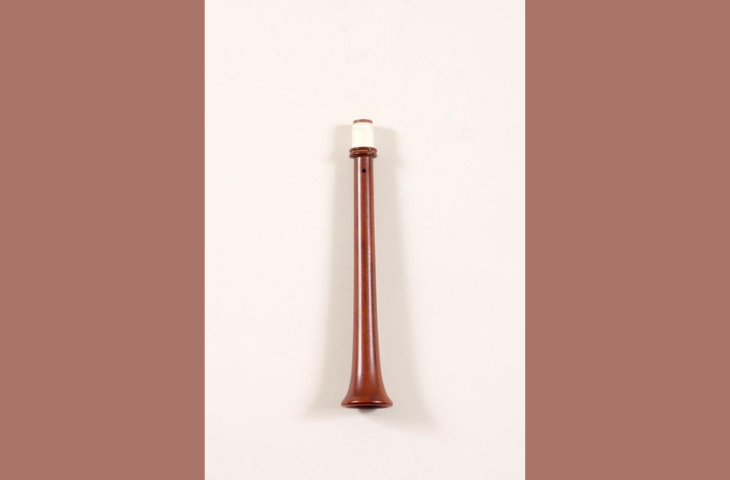May 2024
Fig.1

Xeremies bagpipe, unknown, Majorca, before 1896, inv. 2006
Fig.2

Xeremies bagpipe (grall), unknown, Majorca, before 1896, inv. 2006
Fig.3

Single idioglote reed
The xeremie bagpipe, a traditional instrument from the Balearic Islands
The xeremie bagpipe (fig.1) is a typical instrument from the Balearic Islands (Spain). It is traditionally made from a bag of skin, but some modern examples have a bag made of synthetic material, such as polymer. This bag, or sarró, acts as an air reservoir, which is then directed by pressure from the elbow to the three sound pipes. A fourth pipe, the bufador, is used to inflate the bag.
The instrument consists of:
- The bufador (“blower”): used to blow air into the bag;
- The grall (fig.2), the oboe that plays the melody;
- The bordons (drones), generally three in number, which produce a single note that sounds continuously. The largest (trompa) is always sonorous, but sometimes the two smallest pipes are purely decorative. They are then called fillols. When all three sound, the drones give the notes C (low), G, and C respectively.
Each sounding pipe is fitted with a single idioglote reed, i.e., a slat cut from a reed tube without being completely detached from it (fig.3).
Living tradition in Majorca
This type of bagpipe is still common in the mountains of Majorca today. It is primarily played in an ensemble consisting of a flageolet (flabiol) and a drum (tamborino), both played by the same musician, as well as a pair of castanets (see video). This small ensemble animates popular dances such as the jota (see video) or the mateixa, one of its variants. These dances are performed during major events in rural life, such as the end of the harvest or the grape harvest.
The xeremie is also performed at religious festivals, sometimes as a simple duet with the flabiol.
This copy was built before 1896. The maker is unknown.
Text: Juan Manuel Fernández Padilla
Bibliography
- Caufriez, A., « L’instrument de musique traditionnel ibérique », Bruxelles, Musée Instrumental, 1988.
- List of the parts of the xeremia : https://web.archive.org/web/20141215165936/http://www.tourism-mallorca.com/xeremiers/01xerem/10xerem.html